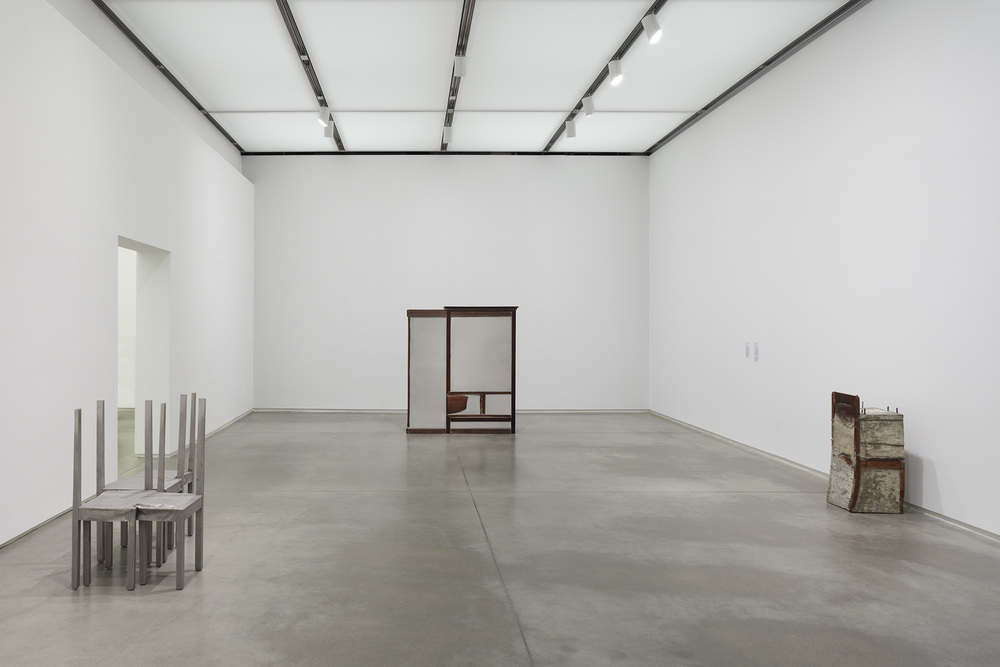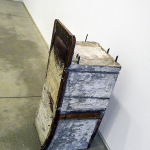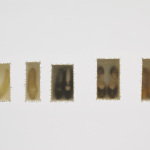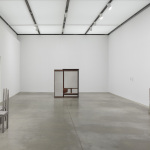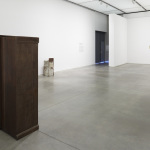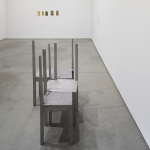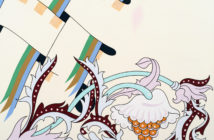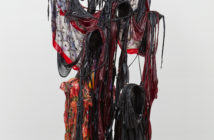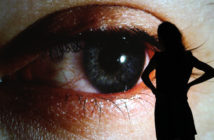In a quiet little corner of the ICA, a room has been set aside for a small group of sculptures by Salcedo. It is micro-retrospective, with each sculpture representing a phase of Salcedo’s career.
All of Salcedo’s sculptures commemorate some person or tragic event. However, we don’t always know what that event is. Salcedo wants us not to know or rationalize away the experience of a person half a globe away but to feel it. Her pieces of useless furniture enable us to feel, if only slightly, how strange the ordinary space of a house is when someone is missing from it. The sculptures, ordinary pieces of furniture, become surreal. She renders them so by filling the empty spaces of wardrobes and chairs, where bodies would sit or personal items would be kept, with thick, dull concrete.
The most well-known piece in this little collection titled Atrabiliarios comprises a set of old shoes, which have been gently propped in niches built in the wall of the gallery. Animal fiber sewn with crude stitches covers the niches. In this way, these relics are ushered into a quasi-mystical space, separate from us, dimmed and obscured by the dried membrane that seals them away. Salcedo chose to treat shoes as relics because they have an intimate relationship with the people who wore them. They bear the touch of their former owners in their creases and scuffs. These represent the shoes of the disappeared. Often, when a buried body was found in Colombia, the only way that family could identify a loved one was through the shoes.
By a nearby wall sits a chair sunk in a block of concrete. The concrete is rough and pitted, exposing its rebar; treated in an almost painterly manner with its surface worked to emphasize the crumbling texture. Looking like debris from a demolished home, the chair, bearing up the weight of this chunk of construction material seems to suffer in weary silence. These works recall Joseph Beuys’ sculpture Fat Chair of 1964, in which the empty space of the seat has been filled with lard. But Beuys’ piece, while also evoking the human body, does not have the same grim feel of Salcedo’s. In Salcedo’s work, the body has been transformed from fat to bone in the form of concrete.
Near the far wall stands a great wooden wardrobe filled with concrete, which is a chalky substance against the dark stained wood. Out of the body of the wardrobe and the depths of the concrete, the back of a chair emerges. This piece from the latter half of the 1990s represents a point where Salcedo changed the way she treated the concrete with which she worked. The concrete has been poured smoothly, rendering the front of the wardrobe into a two-dimensional linear composition with the edges of the shelves reduced to silhouettes.
Throughout her career, Salcedo has made objects that she intends to be observed from the front and against a wall. In her early pieces, Salcedo used the wall of the gallery as part of the composition—as a ground against which to arrange linear elements of metal pipes or wire. In a similar manner, this particular piece de-emphasizes its bulkiness in favor of its visual, linear qualities. In doing so, the piece forces the viewer to stand at a distance in order to study it. All of Salcedo’s sculptures insist on this kind of distance from the viewer. The chair tucked into the wardrobe space emerging or disappearing into the pool of concrete is ghostly. It transforms before our eyes.
 Image from Daniel Rolnik of Argot & Ochre
Image from Daniel Rolnik of Argot & OchreIn Salcedo’s most recent sculptures, she has moved from using found objects to making these objects out of cast metal. The material mimics the grain of the wood but allows for greater manipulation of the body of the chair. In these metal sculptures, the chairs are broken, their backs missing or partially missing transforming the ribs into dangerous-looking spikes. They have been fused together with some of the metal is crumpled, as if it had been crushed. If these chairs are substitutes for bodies, these are bodies that have broken and bruised, and even transformed into weapons in their own right.
Salcedo’s work comes loaded with the symbolism of childhood, of origin and nature, and seems to address the viewer as another conscious being. The utensils and furnishings of a home receive the traces of their touch and wear on its surfaces the way a shoe receives the imprint of a foot. These furniture pieces should recall the warmth of home, which shelters and embraces its human inhabitants. However, when they are suffocated in concrete, the chair, which should acknowledge and embrace the body, becomes pure surface, destroying the sense of warmth and humanness. The piece becomes a dumb object before the viewer. Salcedo, in fact, has aptly described her work as half-present, or disappearing.
Entering this room after leaving the main exhibition space, walking down the glass hallway overlooking the harbor, was a remarkable experience. The installation was a welcome lull after the more spectacular and noisy show in the main exhibition space. With each sculpture given a generous amount of space, it seems as if the curators intuited how the sculptures demand the viewer to stay at a distance to contemplate them individually.
Some have described Salcedo’s work as a form of the experience of trauma. However, the experience may be more accurately described as having someone familiar smile at you but then inexplicably turn blindly away. There is little wall text in the space, perhaps because little is necessary. Salcedo relies on her materials to do what a newspaper account of violence in a distant country cannot: Evoke a viewer’s empathy for another’s suffering by helping them to feel it.
- Image from Daniel Rolnik of Argot & Ochre
- Doris Salcedo, Atrabiliarios , 1992. Installation at ICA, Photo credit: Charles Mayer.
- Installation at ICA, Photo credit: Charles Mayer.
- Installation at ICA, Photo credit: Charles Mayer
- Installation at ICA, Photo credit: Charles Mayer.

